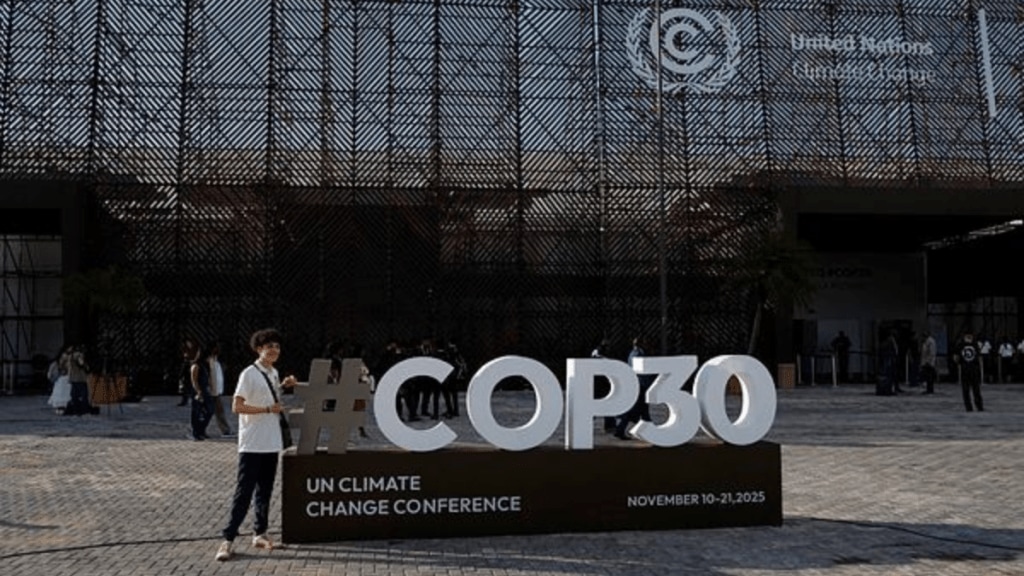By Pranav Master & Rathin Kukreja
The 30th annual Conference of Parties to the UN Framework Convention on Climate Change (COP30) currently underway in Brazil provides India a platform to demonstrate its progress on climate action & attract international finance to power the next stage of growth, write Pranav Master & Rathin Kukreja
Climate goals vs performance
The COP 30 is expected to crystallise the outcomes of the Global Stocktake — done once in five years to assess the world’s collective progress on climate action — pushing nations to become more ambitious with their Nationally Determined Contributions (NDCs) and to deliver on long-term promised climate finance.
Under its updated NDCs, India pledged a 45% reduction in emission intensity of gross domestic product (GDP), achieving 50% of its installed power capacity from non-fossil fuel sources and creating an additional carbon sink of 2.5-3 billion tonne of CO2 equivalent — all by 2030.
India has achieved these goals ahead of time. It reached the 50% non-fossil power capacity milestone five years before the 2030 target, reduced GDP emission intensity by 36% between 2005 and 2020, and created an additional carbon sink of 2.29 billion tonne of CO2 equivalent over 2005-2021 against its 2030 target.
It is now on course to reach the goal of net-zero emissions by 2070. India’s success stems from a deliberate strategy with the right mix of policy, technology and resolve. Few large economies can claim such tangible progress while sustaining healthy economic growth.
Pragmatic approach to energy transition
Strong policy and market reforms are helping India accelerate transition in power, transport and industry. In power, renewable energy capacity has surpassed 190 GW (as of September 2025), led by solar and wind, and is moving towards 500 GW by 2030.
Electric mobility is accelerating, with over two million electric vehicles (EVs) sold in FY 2025, enabled by FAME-II, falling battery costs and expanding charging networks. Industry is moving toward decarbonisation through efficiency programmes such as Perform, Achieve and Trade; Renewable Consumption Obligations and the pilot green hydrogen projects in fertiliser and steel.
However, coal still makes up nearly 70% of the generation, underlining the scale of transition that is required. India’s approach remains pragmatic—pursue clean energy while ensuring reliability, affordability and energy access for its growing economy.
Mobilising climate capital
Affordable and long-term finance is a critical piece in India’s energy transition puzzle. As traditional sources of finance reach their limits, innovative climate finance instruments are emerging as the key to sustaining the sustainability momentum.
India is gradually treading this path.
The cumulative issuance of green, social, sustainability and sustainability-linked (GSS+) instruments has crossed ~$55 billion. Of this, 85% of the proceeds were raised through green labelled instruments and have been largely channelled to low-carbon energy projects. This underscores India’s ability to draw climate-aligned capital.
However, the scale of the challenge is daunting. To achieve the net-zero target by 2070, the country will require an estimated $10 trillion in cumulative investments, leaving a financing gap of $3.5 trillion, as per CEEW-CEF.
The roadblocks
As renewable energy penetration rises, grid integration challenges and curtailment risks could intensify without concomitant investments in transmission and energy storage. Land acquisition and permitting delays also continue to hamper project execution. Compounding these issues is the fragile financial health of the state power distribution companies.
On the industrial front, hard-to-abate sectors lack affordable and scalable decarbonisation pathways, slowing the transition. Also, policy, regulatory and institutional inconsistencies across states hinder innovation and scaling up. The underdeveloped domestic manufacturing ecosystem for solar modules, batteries and electrolysers is also concerning.
Limited investments in research and development, skilling and supply chain integration have led to a high dependence on imports, thereby exposing the country’s energy transition to global supply risks.
Overcoming the challenges
Clear and predictable policy and regulatory frameworks will attract investments. Upgrading transmission networks and reforming discoms will be vital for reliable renewable integration. Targeted support for low-carbon manufacturing, green industrial clusters and demand-side incentives will be critical.
Strengthening domestic manufacturing can reduce the import reliance in renewables. Developing a transparent carbon market and ensuring clear pricing signals will drive efficiency and attract investment. Expanding the Carbon Credit Trading Scheme to more sectors and timely introduction of voluntary carbon markets will further align capital with climate goals.
On the financing side, India should establish a sustainable finance taxonomy, introduce sustainable investment mandates, build market capacity and set robust measurement and verification standards. Expanding blended finance models such as concessional capital can lower project risks and attract investors. Finally, at COP30, India should advocate stronger financial support for developing nations to advance their climate goals.
Master is senior practice leader and director while Kukreja is director at Crisil Intelligence


